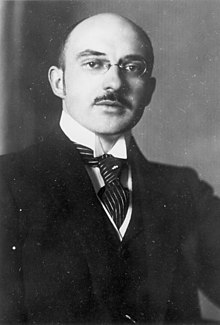Max Erwin von Scheubner-Richter
You can help expand this article with text translated from the corresponding article in German. (December 2009) Click [show] for important translation instructions.
|
Max Erwin von Scheubner-Richter | |
|---|---|
 Max Erwin von Scheubner-Richter | |
| Birth name | Ludwig Maximilian Erwin Richter |
| Born | 21 January 1884 Riga, Russian Empire |
| Died | 9 November 1923 (aged 39) Munich, Weimar Republic |
| Allegiance | |
| Branch | |
| Years of service | 1914–1918 |
| Unit | 7th Bavarian Chevauleger-Regiment Straubing (August–November 1914) |
| Battles/wars | Russian Revolution of 1905 World War I Beer Hall Putsch |
Ludwig Maximilian Erwin von Scheubner-Richter (
Scheubner-Richter was a
Scheubner-Richter was killed during the Beer Hall Putsch in November 1923 and part of Hitler's Mein Kampf was dedicated to him. He was elevated to status of Blutzeuge ("blood witness") and national hero upon the founding of Nazi Germany in 1933. Of the 15 Nazis killed during the coup, Hitler described Scheubner-Richter as the only one who was "irreplaceable".
Early life
Ludwig Maximilian Erwin Richter was born on 21 January 1884 in
World War I and Armenian genocide
On 10 August 1914, shortly after the outbreak of World War I, Scheubner-Richter joined the Bavarian Army as a volunteer and was assigned to the 7th Chevauleger Regiment on the Western Front. However, Scheubner-Richter was relocated to the Eastern Front from November 1914, where Germany was fighting the Imperial Russian Army, after one of his superiors discovered his knowledge of the Russian language.
In December 1914 Scheubner-Richter became the German
Nazi activity
In 1918, Scheubner-Richter and
Scheubner-Richter was particularly noteworthy for his extensive contacts with
At the end of September 1923, Scheubner-Richter provided Adolf Hitler with a lengthy plan for revolution, writing: "The national revolution must not precede the seizure of political power; the seizure of the state's police power constitutes the promise for the national revolution" and "to lay hands on the state police power in a way that is at least outwardly legal".[13]
Death
Scheubner-Richter was a participant in the Beer Hall Putsch, marching on the Feldherrnhalle in Munich along with two thousand NSDAP members. On 9 November 1923, Scheubner-Richter, walking arm-in-arm with Hitler, Richter was shot in the lungs and died instantly as he and others marched toward armed guards during the Putsch.[14] Hitler was brought down and his right shoulder was dislocated as Scheubner-Richter's body fell after being shot dead.
Scheubner-Richter was the only "first-tier" Nazi leader to die during the Beer Hall Putsch, and of all the early party members who died in the Putsch, Hitler claimed Scheubner-Richter to be the only "irreplaceable loss".
In 1933, the establishment of
See also
References
- ^ ISBN 978-3-0340-0561-6.
- ^ Schaller, Dominik J. (2002). Kieser, Hans-Lukas; Schaller, Dominik J. (eds.). Armenian genocide and the Shoah. p.131
- ISBN 0-8050-8665-X
- ISBN 0-493-30243-3.
- ISBN 1-4128-3965-3.
- ISBN 978-1-903656-81-5.
- ^ Herwig, Holger (10 Feb 2007). "Documenting a 'shameful act': Turkish emigre historian writes on Armenian genocide". The Gazette. Montreal. p. J5.
Interestingly, Max von Scheubner-Richter as German vice-consul at Erzerum in 1915 reported the Ottoman policy of "annihilation" of the Armenians to his government; as a Nazi ideologue, he died at Adolf Hitler's side during the infamous "Beer Hall putsch" of November 1923.
- ^ Kaiser, Hilmar (2002). Kieser, Hans-Lukas; Schaller, Dominik J. (eds.). Armenian genocide and the Shoah. p.137
- ^ Kaiser, Hilmar (2002). Kieser, Hans-Lukas; Schaller, Dominik J. (eds.). Armenian genocide and the Shoah. p.139
- ^ Kaiser, Hilmar (2002). Kieser, Hans-Lukas; Schaller, Dominik J. (eds.). Armenian genocide and the Shoah, p.143
- ^ Kaiser, Hilmar (2002). Kieser, Hans-Lukas; Schaller, Dominik J. (eds.). Armenian genocide and the Shoah, p.144
- ISBN 9780521070058.
- ^ Heiden, Konrad. Der Fuehrer: Hitler's Rise to Power. New York: Houghton Mifflin Co, 1944, p. 184.
- ISBN 0-385-42053-6.
- ISBN 0-06-055870-9.
